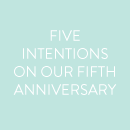Marvelous Money: Making a yearly budget
Around this time every year, I start to feel a little anxious about the coming year — specifically the finances of the coming year. By November, we’ve usually started talking about things like vacations we’d like to take, purchases we want to make, and savings goals we’d like to hit. We’ve submitted our pledge to our church. We know what our childcare expenses are going to be. But I don’t yet have a map of how it’s all going to fit together, and so I start worrying: will we be able to pay for everything we want to do? Will we have the money to take these vacations we’re talking about? Will we need to trim our budget, or will we get to expand it?
I hate that anxious feeling. And I think that’s how I’d feel every month if I didn’t have a budget, because a budget is a plan. It reassures me that I’ve taken care of everything that I need to, and that if I stick to the budget, I am free to spend money without guilt, I don’t need to worry about paying bills, and I can rest assured that I’m making progress on all of my savings goals.
I LOVE feeling like that. So this weekend, John and I sat down and made a plan for 2017. We do this every year, and I’d encourage y’all to try it, too! Here’s what we did.
We started by setting aside about two hours, after June was in bed so we wouldn’t be interrupted. We opened up a fresh Google doc and copied and pasted the structure of our budget (formulas, categories, etc. – you can read more about that here). Then we started adding in numbers:
First, we entered in any fixed amounts: numbers that we can’t change or don’t plan to change, on both the income and expense side. A few examples: our salaries, 401k contributions, taxes, and our mortgage.
Then, we moved to the “slightly flexible” categories: ones where we could make changes, but there’s not a ton of wiggle room and it would require a lot of effort. A few examples: childcare, cable and internet, charitable giving, and groceries.
Finally, we enter in what we’d like to spend in the flexible categories. A few examples: vacation, dining out, gifts, and clothing.
Depending on whether or not you’ve kept a budget in the past, it will be more or less challenging to pull these numbers. Since we have a lot of data to look back on, we were able to simply plug in a lot of numbers from 2016. Still, we do talk through each category to see if any adjustments are needed for the upcoming year: Are we due for new tires? Will we be flying more than usual? Will we be buying lots of wedding gifts? If you haven’t kept a budget in the past, look back on a month or two of receipts or credit card statements to help you estimate.
Now it’s time to look at the bottom line: With all of your projected income and expenses taken into account, is your budget for the year in the black or in the red?
If it’s in the black: great! When we have a less than $1,000 surplus, we leave our budget as-is, because that’s a small enough amount to us. However, if the surplus were more than $1,000, I’d want to assign that money somewhere (savings, giving, or an expense category), because the goal is for every dollar to have a job.
This year, when we first did the math, our projection was in the red. But no need to panic! This is why we forecast a budget, so we’re not realizing this next October, or whenever our bank accounts run dry.
If you’re in the red, too, it’s time to go back over all of those flexible and semi-flexible categories with a fine-tooth comb, and talk through any options for cutting your expenses. For us, we talked about reducing our vacation, home, clothing, personal care, and childcare expenses. We also decided to forgo one month of extra payment on our mortgage in order to make room for the additional money we want to give to our church’s building campaign next year. These are tough decisions, but I firmly believe it’s better to make them now, when you’re in control, rather than when you’re scrambling and your options are limited. Cut, cut, cut until your budget is balanced.
Once your numbers come out even, congratulations! You have a financial road map for 2017, and it’s going to be an awesome year!!
Your next step is to set up a system to track your budget every day, week, or month, like through a Google doc, an online system like Mint or YNAB, or the envelope system.
You’ll also want to make plans to check in periodically to see how you’re pacing – we do that every two months. After all, a budget is a plan, but plans can change. We adjust our budget throughout the year if our circumstances change or if we decide we want to prioritize one category over another. That’s totally fine to do, as long as the income and expenses balance out in the end!
I’d love to hear, friends: do you do any budget planning before a new year begins? How do you track your budget? Does talking about a budget give you the heebie-jeebies? Are there any money topics I can help you with in upcoming posts? I have a few brainstormed, but I would LOVE to hear what might be most helpful to you!!
P.S. More marvelous money posts: paying off debt, preparing financially for a baby, and paying for a car in cash.





















I love the idea of planning for the whole year! We enjoy budgeting through Mint but usually only for day to day expenses (groceries, utilities, gas, etc.). It makes total sense, though, to go ahead and calculate funds needed for larger purchases like wedding and/or baby gifts (most of my married friends are welcoming babies left and right!) or hefty maintenance fees like tires or a new roof (a purchase we will have to tackle next year). Thanks for the inspo – will be sitting down with my husband soon to make a financial road map of our 2017. :) P.S. Kudos to you guys for paying extra on your mortgage! *virtual high five*
Right there with you, friend! So glad we’re in this thing together!!
Em, big fan of your blog and I just love your Marvelous Money posts! Right now we track our budget with a complex spreadsheet and it’s become time consuming and cumbersome. Wold love to know if you have a personal preference with Mint or YNAB? I feel like I spend way too many hours each month going through receipts, credit card statements, etc. dividing everything up and know I need an online system to help with this. Would love any input you might have!
Hi Kathryn! Thank you so much!! I have used Mint in the past and would get frustrated because it was not very accurate with categorizing my expenses, applying returns correctly, etc. However, it’s been several years since I’ve used it, and they may have improved some features. I’ve never personally used YNAB, but it looks amazing, and my recommendation would be to start exploring there! I do know people who use and love both.
Em, this is so helpful! We have a spread sheet with our monthly budget goals, but not a yearly plan – we are def going to get on that after reading this.
Do you manually track your budget each month? or each week? We’ve been tracking monthly, but honestly, its a pain! I’m trying to find a way to do it in a more automatic fashion, but like you, Mint was a mess for me in the way it categorized things.
Hi Hannah! I’m so glad it was helpful! We do manually track our budget. John and I have split up our accounts, so he inputs data from certain credit cards and accounts (the ones he uses more often), and I do the same for a different set. I’d say we go in and add numbers about every two weeks. Since we very rarely pay for things in cash (and so don’t have to worry too much about referencing receipts) and only use three cards, it’s not too difficult! The only thing that usually trips me up is Target, because those purchases usually span across several budget categories :)
Great post! Last year for the first time, we listed all of our once-yearly expenses and other things like out of town weddings, and divided those costs by month to save up throughout the year, and it made life so much easier when those expenses came due. Otherwise, all of our budgeting is on a monthly basis. I really like the idea of forecasting it over the whole year, and making sure we’re in the “black”!
PS- love this series!